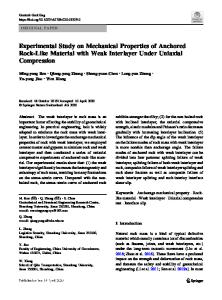A Comprehensive Experimental Study on Mechanical Behavior, Microstructure and Transport Properties of 3D-printed Rock An
- PDF / 11,701,928 Bytes
- 21 Pages / 595.276 x 790.866 pts Page_size
- 103 Downloads / 361 Views
ORIGINAL PAPER
A Comprehensive Experimental Study on Mechanical Behavior, Microstructure and Transport Properties of 3D‑printed Rock Analogs Rui Song1,3 · Yao Wang1,2 · Sergey Ishutov2 · Gonzalo Zambrano‑Narvaez2 · Kevin J. Hodder2 · Rick J. Chalaturnyk2 · Shuyu Sun3 · Jianjun Liu1,4 · Ranjith P. Gamage5 Received: 16 March 2020 / Accepted: 25 August 2020 © Springer-Verlag GmbH Austria, part of Springer Nature 2020
Abstract 3D-printed (3DP) analogs of natural rocks have been used in laboratory tests concerning geomechanical and transport properties. Rock analogs manufactured by 3D printing can be used to manufacture batch of the samples with specified heterogeneity compared to natural rocks. Rock analogs were manufactured with silica sand (SS) and gypsum powder (GP) using binder jetting as well as with coated silica beads (CSB) using selective laser curing. The uniaxial and triaxial compressive tests were conducted to investigate the strength and deformation characteristics of 3DP rocks that were quantitatively compared with natural rocks. CSB and SS specimens experienced tensile failure, while the GP specimen has shown shear failure and shear-expansion behavior. The microstructural characteristics (e.g. grain shape, pore type, and bonding form) of the SS specimen were similar to a natural sandstone (Berea sandstone reported in the literature) with a relatively loose texture. In addition, 3DP rocks were more permeable than Berea sandstone (permeability of SS, CSB, and Berea sandstone was 12580.5 mD, 9840.5 mD, and 3950 mD, respectively). The effect of microscopic mechanical behavior on macroscopic strength and failure characteristics was investigated using scanning electronic microscopy. CSB and SS specimens could be suitable to simulate the transport behavior of the highly permeable sedimentary rocks. The GP specimen could be used to study the large deformation characteristics and creep failure mode of highly stressed soft rocks. Despite the early stage of 3DP rock analog studies, the potential applications could be expanded by controlling the physical properties (e.g. wettability and surface roughness). Keywords 3D printing · Compressive strength · Deformation and failure · Microstructure · Computed tomography
1 Introduction * Yao Wang [email protected] * Jianjun Liu [email protected] 1
School of Geoscience and Technology, Southwest Petroleum University, Chengdu 610500, China
2
Department of Civil and Environmental Engineering, Donadeo Innovation Center for Engineering, University of Alberta, Edmonton T6G 1H9, Canada
3
Computational Transport Phenomena Laboratory (CTPL), King Abdullah University of Science and Technology (KAUST), Thuwal 23955‑6900, Kingdom of Saudi Arabia
4
State Key Laboratory of Geomechanics and Geotechnical Engineering, Wuhan Institute of Rock and Soil Mechanics, Chinese Academy of Sciences, Wuhan 430071, China
5
Deep Earth Energy Research Laboratory, Department of Civil Engineering, Monash University, Melbourne, VIC 3800, Australia
A rock is a natural porous me
Data Loading...











